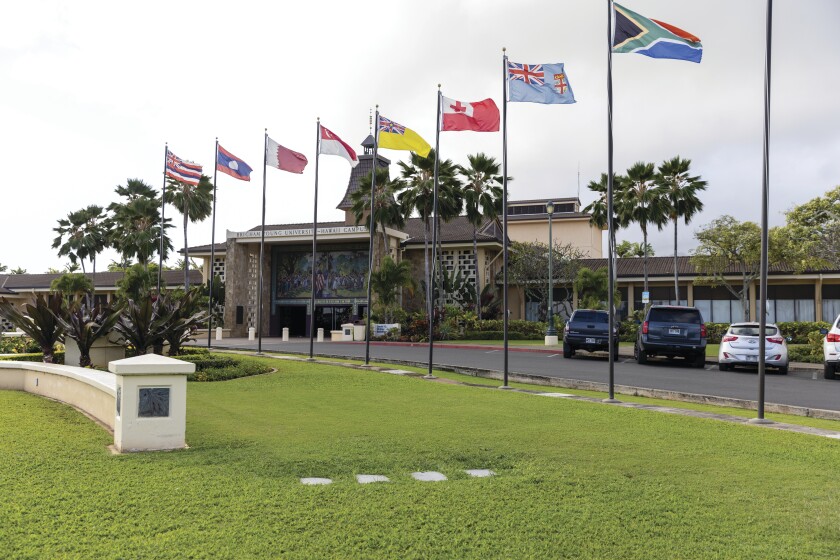
With only sugar cane fields as a canvas, labor missionaries turned BYU–Hawaii into the thriving ecosystem that it is today. Labor missionaries needed to plant more than 27,000 plants, according to the first labor missionary yearbook published in 1958, which included importing plant species that were not available in Hawaii.
As a solution, Brother Harry Hing, a labor missionary and the first landscape foreman for campus, created a nursery to raise the thousands of seedlings that now make up the vegetation on campus. They also relied heavily on donations of trees, fulfilling the seven-year landscaping project while only making one purchase of $10 on two yellow Samoan coconut palms placed at the front entrance for the dedication, the yearbook explains.

The yearbook adds, “What is being accomplished is more than man-made plans. As Brother Hing says, ‘I know that the Lord has His hand in what we are doing. Things that are happening couldn’t just happen by chance.’”
Donations of trees and service
According to the yearbook, Church members as well as non-members donated fully grown trees. Mark James, a retired TESOL and linguistics professor at BYUH, is the Hawaii Regional Church History adviser for the Church History Department in Salt Lake City. He said many of these mature trees, especially the coconut trees, were donated by local families.
The yearbook says the palm trees shading the swimming pool were donated by the J. Kaya store in Punaluu and the bamboo palms by the library and cafeteria were donated straight out of Brother Arthur Parker’s yard in Honolulu.

The yearbook says, “Brother Hing feels that the way valuable trees are being donated so generously is a definite manifestation of divine aid.”
The donated coconut palms and lauhalas represent major savings, the yearbook says, because the full-grown trees would have cost about $125 each, which would be about $1,200 per tree in today’s currency, according to the USD Inflation website.
According to James, two of the original lauhala can be found on the “south side of the McKay complex near the old cafeteria entrance.”
BYUH’s iconic trees
The original faculty of BYUH also participated in gathering trees for campus. James said Wylie Swapp, one of the first professors in the Faculty of Art, “coordinated the round-up and planting of hundreds of very young coconut trees in the late ‘50s. These can be seen all over campus today.”
However, many of the other faculty’s contributions are not seen today, as James explained some trees have been removed since the opening of campus. James noted one of these contributions no longer standing. Patrick Dalton, one of the original professors in what was then called the Faculty of Agriculture, planted exotic trees on campus with nameplates installed as the base of each, said James.

Some of the removed exotic trees were the Chinaberry trees, James added, which were located by the art classrooms, as well as the paperbark tree in the science courtyard. The new cafeteria took the place of the famous Banyan tree, which was known as the “broccoli tree” before it was removed.
James said the most important, iconic tree still standing today is the massive shower tree that faces the motherhood statue in the art courtyard in the McKay complex. It has become an icon due to it being the “last of the giants’ and one of the few remaining original courtyard trees from the early days of CCH [Church College of Hawaii],” he said.

Personal connections
Yahneli Garcia, a freshman from Utah majoring in business, said she is particularly fond of the campus courtyards that hold a special place for her. Whenever she is in need of peace throughout the day, Garcia said she escapes to one of the courtyards because there “you can have your own privacy and … be in your own head space.”


James said his favorite part of landscaping has been removed. He said when he was a student at BYUH there were two strawberry guava trees next to the Museum of Natural History. “I always enjoyed eating a handful on the way to class and eating a handful on the way back.”
One of the most recent changes to the landscaping has occurred over the past few years with the focus on upgrading the turf on campus, James said. “The installation of El Toro grass and the hiring of outside contractors has made a huge difference in the lush look of the campus in recent years.”
Julia Rigby, a freshman from Texas whose major is elementary education, said she personally benefited from the recent changes since she discovered the newly built turf field as her favorite spot on campus. “I love to play sports, and it’s a way for me to connect with people and have fun and meet new people,” she said.•


